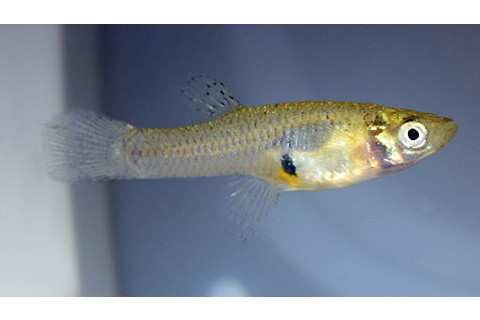
The history of Bahamas mosquitofish is written in their genitals. Though you'd have a hard time locating a female fish's reproductive parts, they tell a story of predators, suitors, and finding a way to regain control. Gambusia hubbsi arrived at Andros Island, in the Bahamas, about 15,000 years ago. The little fish live in vertical, water-filled caves called blue holes. Populations separated from each other by these caves are in the process of evolving into different species, pushed by the pressures of their particular homes. For example, in some blue holes, the fish live with few threats. In others, mosquitofish swim alongside their predator, a fish called the bigmouth sleeper (Gobiomorus dormitor). The color, shape, and swimming performance of mosquitofish have all evolved differently depending on whether these predators are around. Another trait evolving differently across mosquitofish populations is their genitals. In the past, researchers studying mosquitofish—and other rapidly changing species—have focused on male genitalia. But North Carolina State University biologist Brian Langerhans thinks it's time to take a closer look at females. Langerhans and his colleagues studied 109 female Bahamas mosquitofish from 14 separate caves. About half the caves had predators, and the rest didn't. The researchers studied a piece of female anatomy called the urogenital aperture, which is a fancy way of saying "pee/sex hole." (Males use a modified fin called the gonopodium to put sperm into the female's aperture. Unlike most fish, which fertilize their eggs outside their bodies, mosquitofish fertilize their eggs internally and give birth to live young.) Looking for differences between cave populations, the scientists measured every possible aspect of the female fishes' urogenital apertures: width, length, area, shape, and so on. They found a big difference between females from homes with and without predators. Females in predator-free populations had genital openings nearly twice as large as females living with predators. Langerhans thinks this difference is a way for females under pressure to take control of their mating process. In caves with no predators, Langerhans says, the carefree mosquitofish take their time with mating. Males have exaggerated colors and perform elaborate courtship routines, which females can judge to choose their mates. But when predators are lurking, the little fish can't afford to dilly-dally. Males dispense with courtship and instead try to mate with females quickly—even forcing their way in. Evolving smaller genital openings, Langerhans says, may be females' response to these aggressive mating attempts. Copulation in mosquitofish requires "performing a complicated torque-thrust maneuver," the scientists write, in just 20 to 50 milliseconds. It's tricky even with a female's cooperation. By making things even harder for males, females may be able to keep out the ones they don't want and exert some choice over who fertilizes their eggs. "The extremely rapid and athletic copulation behavior...now additionally involves an especially small target," Langerhans says, "which is also a moving target, since the female can obviously swim." In an earlier study, Langerhans found that male mosquitofish living with predators have evolved different genitalia too. Under pressure to copulate quickly, these males have developed gonopodia with longer tips that are more densely covered in bony structures—perhaps for gripping. The new study suggests that the smaller female openings haven't exactly evolved in response to the changing male genitalia, but independently, under the same pressure from predators. Yet Langerhans says the shape (not size) of female genitalia, which is somewhat more elongated in predator-free populations, does seem to have evolved along with the changing male shape. This would help maintain a "lock-and-key" fit between the two sexes, ruling out interbreeding with other populations that are still within swimming distance. It might seem that Langerhans has exhausted the questions there are to ask about mosquitofish genitals. But he says that's not the case. "We are trying to understand the function of the genital [shapes]," he says, and to link that to how new species evolve. In the long term, he hopes to understand the genetic changes that are behind these fishes' morphing bodies. And he wants to know how environmental changes caused by humans can drive this kind of evolution—in other words, how our activities are making some animals' pee/sex hole situations even more complicated.
Image: female Gambusia affinis (not the study species) by Fredlyfish4 (via Wikimedia Commons)
Anderson CM, & Langerhans RB (2015). Origins of female genital diversity: Predation risk and lock-and-key explain rapid divergence during an adaptive radiation. Evolution; international journal of organic evolution PMID: 26259062













